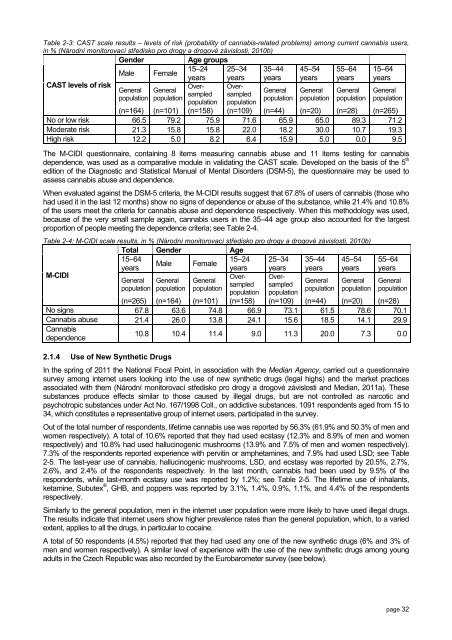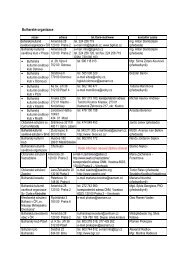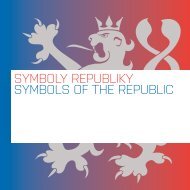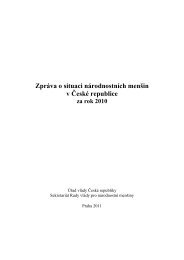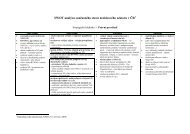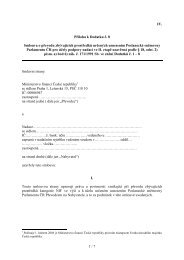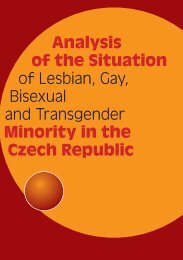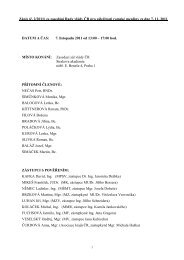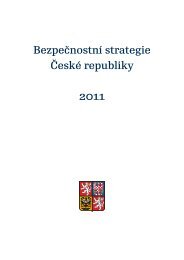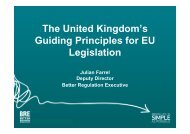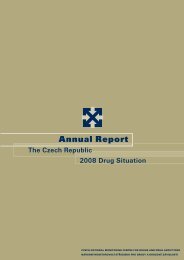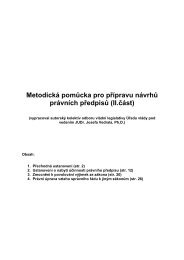The Czech Republic Annual Report 2010 Drug ... - Drogy-info.cz
The Czech Republic Annual Report 2010 Drug ... - Drogy-info.cz
The Czech Republic Annual Report 2010 Drug ... - Drogy-info.cz
Create successful ePaper yourself
Turn your PDF publications into a flip-book with our unique Google optimized e-Paper software.
<strong>The</strong> M-CIDI questionnaire, containing 8 items measuring cannabis abuse and 11 items testing for cannabis<br />
dependence, was used as a comparative module in validating the CAST scale. Developed on the basis of the 5 th<br />
edition of the Diagnostic and Statistical Manual of Mental Disorders (DSM-5), the questionnaire may be used to<br />
assess cannabis abuse and dependence.<br />
When evaluated against the DSM-5 criteria, the M-CIDI results suggest that 67.8% of users of cannabis (those who<br />
had used it in the last 12 months) show no signs of dependence or abuse of the substance, while 21.4% and 10.8%<br />
of the users meet the criteria for cannabis abuse and dependence respectively. When this methodology was used,<br />
because of the very small sample again, cannabis users in the 35–44 age group also accounted for the largest<br />
proportion of people meeting the dependence criteria; see Table 2-4.<br />
Table 2-4: M-CIDI scale results, in % (Národní monitorovací středisko pro drogy a drogové závislosti, <strong>2010</strong>b)<br />
Table 2-3: CAST scale results – levels of risk (probability of cannabis-related problems) among current cannabis users,<br />
in % (Národní monitorovací středisko pro drogy a drogové závislosti, <strong>2010</strong>b)<br />
Gender<br />
Age groups<br />
CAST levels of risk<br />
15–24 25–34 35–44 45–54 55–64 15–64<br />
Male Female<br />
years years years years years years<br />
Oversamplesampled<br />
Over-<br />
General General<br />
General General General General<br />
population population<br />
population population population population<br />
population population<br />
(n=164) (n=101) (n=158) (n=109) (n=44) (n=20) (n=28) (n=265)<br />
No or low risk 66.5 79.2 75.9 71.6 65.9 65.0 89.3 71.2<br />
Moderate risk 21.3 15.8 15.8 22.0 18.2 30.0 10.7 19.3<br />
High risk 12.2 5.0 8.2 6.4 15.9 5.0 0.0 9.5<br />
Total Gender Age<br />
M-CIDI<br />
15–64<br />
15–24 25–34 35–44 45–54 55–64<br />
Male Female<br />
years<br />
years years years years years<br />
Oversamplesampled<br />
Over-<br />
General General General<br />
General General General<br />
population population population<br />
population population population<br />
population population<br />
(n=265) (n=164) (n=101) (n=158) (n=109) (n=44) (n=20) (n=28)<br />
No signs 67.8 63.6 74.8 66.9 73.1 61.5 78.6 70.1<br />
Cannabis abuse 21.4 26.0 13.8 24.1 15.6 18.5 14.1 29.9<br />
Cannabis<br />
dependence<br />
10.8 10.4 11.4 9.0 11.3 20.0 7.3 0.0<br />
2.1.4 Use of New Synthetic <strong>Drug</strong>s<br />
In the spring of 2011 the National Focal Point, in association with the Median Agency, carried out a questionnaire<br />
survey among internet users looking into the use of new synthetic drugs (legal highs) and the market practices<br />
associated with them (Národní monitorovací středisko pro drogy a drogové závislosti and Median, 2011a). <strong>The</strong>se<br />
substances produce effects similar to those caused by illegal drugs, but are not controlled as narcotic and<br />
psychotropic substances under Act No. 167/1998 Coll., on addictive substances. 1091 respondents aged from 15 to<br />
34, which constitutes a representative group of internet users, participated in the survey.<br />
Out of the total number of respondents, lifetime cannabis use was reported by 56.3% (61.9% and 50.3% of men and<br />
women respectively). A total of 10.6% reported that they had used ecstasy (12.3% and 8.9% of men and women<br />
respectively) and 10.8% had used hallucinogenic mushrooms (13.9% and 7.5% of men and women respectively).<br />
7.3% of the respondents reported experience with pervitin or amphetamines, and 7.9% had used LSD; see Table<br />
2-5. <strong>The</strong> last-year use of cannabis, hallucinogenic mushrooms, LSD, and ecstasy was reported by 20.5%, 2.7%,<br />
2.6%, and 2.4% of the respondents respectively. In the last month, cannabis had been used by 9.5% of the<br />
respondents, while last-month ecstasy use was reported by 1.2%; see Table 2-5. <strong>The</strong> lifetime use of inhalants,<br />
ketamine, Subutex ® , GHB, and poppers was reported by 3.1%, 1.4%, 0.9%, 1.1%, and 4.4% of the respondents<br />
respectively.<br />
Similarly to the general population, men in the internet user population were more likely to have used illegal drugs.<br />
<strong>The</strong> results indicate that internet users show higher prevalence rates than the general population, which, to a varied<br />
extent, applies to all the drugs, in particular to cocaine.<br />
A total of 50 respondents (4.5%) reported that they had used any one of the new synthetic drugs (6% and 3% of<br />
men and women respectively). A similar level of experience with the use of the new synthetic drugs among young<br />
adults in the <strong>Czech</strong> <strong>Republic</strong> was also recorded by the Eurobarometer survey (see below).<br />
page 32


